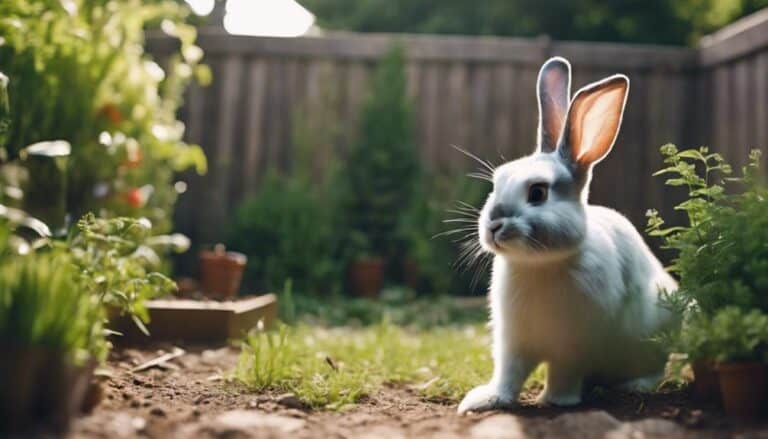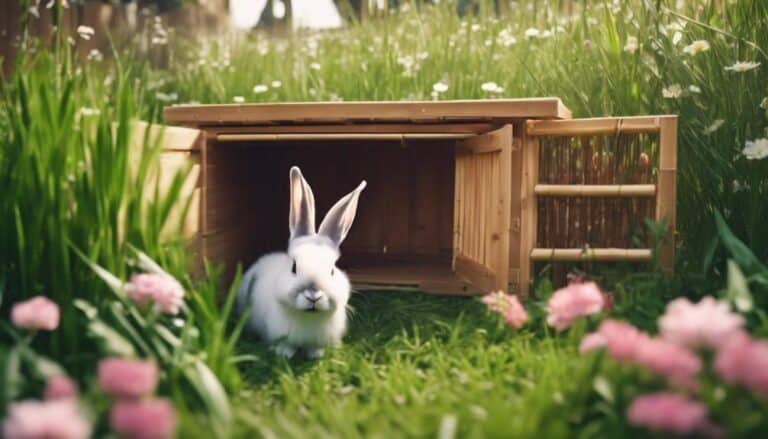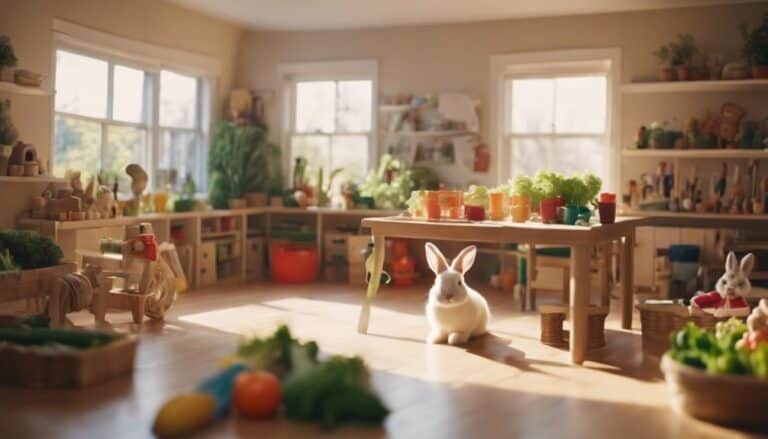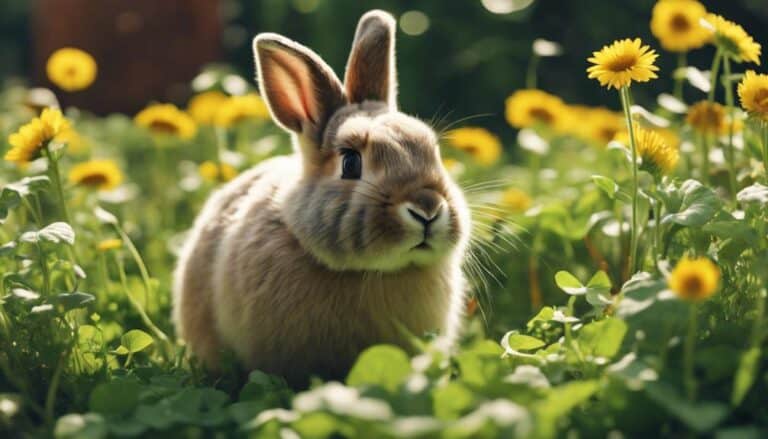Looking to create the perfect cozy abode for your fluffy friends? Have you ever wondered which sustainable materials are ideal for crafting comfortable bunny homes?
Exploring innovative options like bamboo bedding, cork flooring, and mycelium tunnel systems can revolutionize the way you approach eco-friendly bunny habitats. These top sustainable materials not only prioritize the well-being of your bunnies but also contribute to a greener environment.
By incorporating these materials, you can make sure that your bunny's home is both snug and environmentally conscious.
Contents
Key Takeaways
- Bamboo bedding offers natural antimicrobial properties and moisture-wicking capabilities for cozy rabbit homes.
- Hemp nesting material provides insulation, absorbency, and odor control, ensuring comfort and hygiene for rabbits.
- Organic hay feeders promote health benefits and sustainability, enhancing cleanliness and convenience in bunny habitats.
- Recycled paper bedding is soft, absorbent, and environmentally friendly, ideal for burrowing and maintaining rabbit homes.
Bamboo Bedding

Choosing bamboo bedding for rabbit homes offers a sustainable and durable solution, benefiting both the environment and the well-being of the rabbits. Bamboo is an environmentally friendly option due to its rapid growth and renewability, with the ability to regrow within 3-5 years. Its high tensile strength makes it ideal for withstanding the wear and tear that comes with being used as bedding in a rabbit's living space.
Additionally, bamboo possesses natural antimicrobial properties, aiding in keeping the rabbit's environment cleaner and healthier. The moisture-wicking properties of bamboo bedding are advantageous as they help regulate humidity levels in the rabbit's living space, ensuring a comfortable and cozy habitat. Not only is bamboo bedding practical, but it also provides a soft and comfortable surface for rabbits to rest and play on, contributing to their overall well-being and quality of life.
Organic Hay Feeders
Organic hay feeders play an important role in providing rabbits with a natural and safe method to access their essential dietary hay. When considering organic hay feeders for your bunny's home, keep in mind the following key points:
- Health Benefits: By using organic materials like untreated wood or natural fibers, you guarantee that your rabbits aren't exposed to harmful chemicals or toxins that could impact their health negatively.
- Environmental Impact: Opting for eco-friendly materials in hay feeders promotes sustainability by reducing the use of synthetic or non-biodegradable substances, contributing to a healthier planet for future generations.
- Cleanliness and Hygiene: These feeders help prevent hay wastage and contamination, leading to a cleaner living environment for your rabbits and making it easier for you to maintain their habitat.
- Longevity and Convenience: Designed to be durable and easy to clean, organic hay feeders offer a long-lasting solution that requires minimal maintenance, giving you more time to enjoy bonding with your furry friends.
Recycled Plastic Playhouses

When considering options for bunny habitats, you'll find that recycled plastic playhouses offer an eco-friendly choice. These playhouses not only benefit the environment by repurposing plastic waste but also provide durability and weather resistance for long-lasting use.
With a range of designs available, these playhouses combine sustainability with versatility, creating a cozy and engaging space for your rabbits.
Eco-Friendly Playhouse Options
Recycled plastic playhouses offer a sustainable and durable solution for creating eco-friendly play spaces for children. When considering eco-friendly playhouse options, recycled plastic playhouses stand out for their environmental impact and benefits:
- Sustainable Choice: Made from post-consumer plastic waste, these playhouses help divert plastic from landfills, promoting sustainability.
- Durability: These playhouses are weather-resistant and easy to clean, ensuring long-lasting use for outdoor play.
- Variety: Available in various sizes and designs, they offer a fun and safe play space tailored to children's preferences.
- Low Maintenance: Minimal upkeep is required, and their UV-resistant nature guarantees they can withstand prolonged use, reducing the need for replacements.
Benefits of Recycled Plastic
Sustainability-minded consumers can benefit from the durability and environmental advantages of recycled plastic playhouses. These structures are crafted from post-consumer plastic waste, diverting materials from landfills and reducing plastic pollution.
Recycled plastic playhouses require minimal maintenance, offering a hassle-free solution for children's play areas. Their resistance to rot, mold, and insects guarantees a safe and eco-friendly play environment.
Additionally, the production process of these playhouses consumes less energy and water compared to traditional plastic manufacturing, further lessening their impact on the environment. By choosing recycled plastic playhouses, you not only provide a long-lasting and sturdy play space for your children but also contribute to a cleaner, more sustainable future for all.
Design Versatility and Durability
Crafted from repurposed materials, recycled plastic playhouses offer a blend of design versatility and durability, making them an ideal housing solution for pet rabbits. These playhouses are a sustainable choice that not only benefits the environment but also provides long-lasting shelter for your furry friends.
Here's why recycled plastic playhouses stand out:
- Environmentally Friendly: By using recycled materials, you contribute to reducing waste and promoting a greener lifestyle.
- Longevity: Resistant to rot, decay, and pests, these playhouses offer a durable housing solution that will last for years.
- Versatile Designs: With various sizes and designs available, you can create a cozy and engaging space for your bunnies to enjoy.
- Low Maintenance: Easy to clean and maintain, these playhouses offer a practical and sustainable housing option for rabbit owners.
Hemp Nesting Material
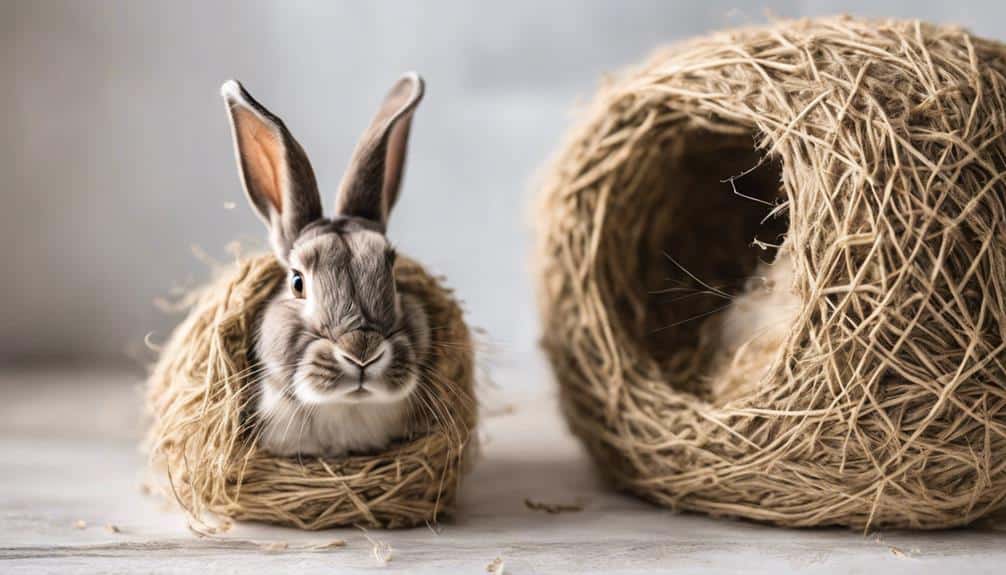
Hemp nesting material offers a sustainable and cozy bedding option for rabbits due to its fast-growing nature, minimal water requirements, and natural insulation properties. This environmentally friendly choice is derived from hemp, a plant that grows quickly and efficiently with minimal water and no need for pesticides. The biodegradable nature of hemp nesting material aligns with sustainable practices, reducing waste and promoting eco-conscious rabbit care.
Rabbits benefit from the comfort and safety provided by hemp nesting material. Its soft and absorbent qualities offer a snug environment for nesting and burrowing, meeting their natural instincts. Additionally, the natural insulation properties of hemp help regulate temperature, keeping rabbits warm and cozy. The odor control abilities of hemp contribute to maintaining a fresh and clean bunny home, enhancing the overall well-being of the furry inhabitants.
Choosing hemp nesting material not only guarantees the comfort of your rabbits but also supports sustainable practices that benefit the environment.
Cork Flooring
Cork flooring offers a multitude of benefits for cozy bunny homes. Its sustainable nature is derived from the bark of cork oak trees that regenerate every 9-12 years, making it an environmentally friendly choice.
With natural resistance to mold, mildew, and pests, cork flooring assures a healthy indoor environment for your furry friends.
Benefits of Cork
With its remarkable natural insulating properties and sustainable sourcing method, cork flooring stands out as a top choice for environmentally conscious and health-conscious homeowners seeking a cozy and eco-friendly living space. Here are some benefits of choosing cork flooring for your rabbit's home:
- Cork oak trees are harvested every 9-12 years without harm, promoting sustainable forestry practices.
- Its natural insulation keeps your rabbit warm in winter and cool in summer, ensuring a comfortable habitat.
- Hypoallergenic properties make it resistant to mold, mildew, and insects, creating a healthier indoor environment.
- The cushioning effect of cork underfoot reduces noise transmission, providing a peaceful atmosphere for your rabbit to hop around.
Opting for cork flooring not only benefits your rabbit but also contributes to a greener planet.
Installation Tips
When considering the installation of cork flooring in your rabbit's home, it's important to pay attention to specific tips that can guarantee a successful and efficient process.
To create a cozy and environmentally friendly living space for your rabbits, start by ensuring the subfloor is clean, dry, and level before installation. Acclimate the cork flooring in the room for at least 48 hours to prevent expansion or contraction post-installation.
Use a high-quality adhesive recommended for cork flooring to secure the planks properly. Leave a small gap around the edges to accommodate natural expansion.
Finish by sealing the floor with a water-based polyurethane to protect it from rabbit living activities and maintain its durability over time.
Wheat Straw Hideouts
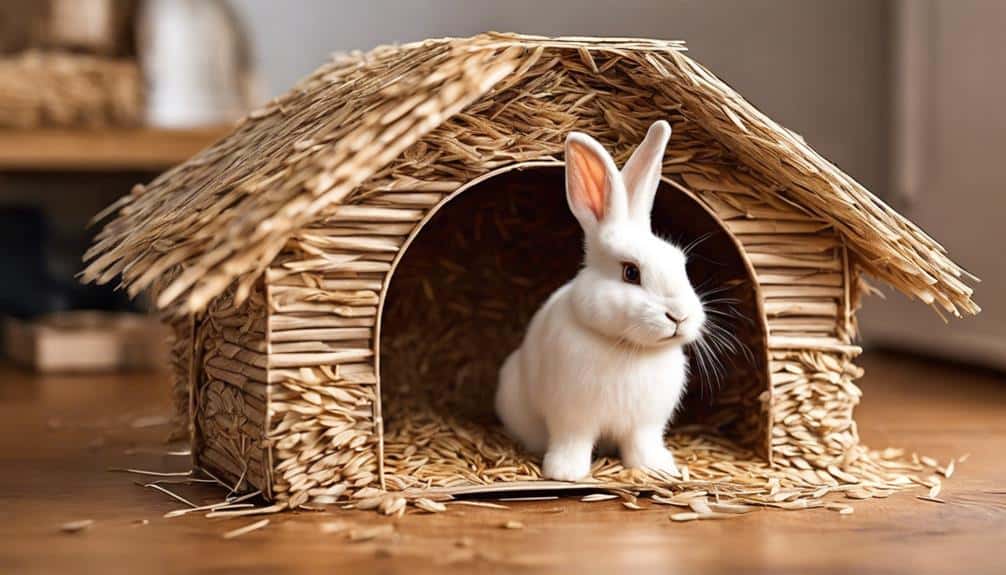
Crafting a cozy and sustainable rabbit home begins with incorporating wheat straw hideouts into the living space. These eco-friendly shelters aren't only kind to the environment but also provide numerous benefits for your furry friends. Here's why wheat straw hideouts are a great choice for your rabbit shelter:
- Natural and Cozy: Wheat straw hideouts offer rabbits a cozy and natural shelter option that mimics their natural habitat, promoting a sense of security and well-being.
- Renewable and Sustainable: Made from renewable wheat straw, these hideouts are environmentally friendly, ensuring that your rabbit's home has a minimal impact on the planet.
- Insulation and Warmth: The insulation properties of wheat straw help keep rabbits warm during colder seasons, ensuring they stay comfortable and cozy all year round.
- Safe and Secure: Wheat straw hideouts provide a safe and secure hiding spot for rabbits to retreat to when they need privacy or comfort, promoting their mental well-being and reducing stress levels.
Mycelium Tunnel Systems
For a sustainable and innovative approach to cozy rabbit housing, consider incorporating mycelium tunnel systems into their living environment. These tunnel systems are constructed using mycelium, which is the root structure of mushrooms, combined with agricultural waste. By utilizing natural materials, mycelium tunnel systems are eco-friendly and sustainable options for creating a strong and durable habitat for rabbits.
One of the key advantages of mycelium tunnel systems is their excellent insulating properties. This feature guarantees that the rabbits have a cozy and comfortable environment within their homes. Additionally, the rapid growth process of mycelium makes these tunnel systems a quick and efficient solution for sustainable rabbit housing.
Additionally, mycelium tunnel systems are biodegradable, offering an environmentally friendly housing option for rabbits. At the end of their lifespan, these structures can be easily composted, minimizing any negative impact on the environment. Consider implementing mycelium tunnel systems to provide your rabbits with a safe, eco-friendly, and sustainable living space.
Frequently Asked Questions
What Is the Best Material for Rabbit Bedding?
For rabbit bedding, consider eco-friendly alternatives like fleece liners or paper-based bedding. Balance comfort and durability to create a cozy environment for your bunnies. Assure cleanliness by regularly changing bedding to promote a healthy living space.
What Materials Are Used in Making Rabbit Houses?
When making rabbit houses, you can use eco-friendly options like natural fibers and recycled materials. Consider biodegradable choices for sustainability. These materials provide comfort and insulation for your bunnies while reducing your environmental impact.
What Materials Are Used for Rabbit Accommodation?
For rabbit accommodation, opt for eco-friendly choices like bamboo, recycled plastic, or reclaimed wood. These sustainable materials not only provide cozy bunny homes but also contribute to creating environmentally conscious and safe habitats.
What Is the Best Housing for a Bunny?
For your bunny, the best housing is a cozy burrow, a safe and snug hideaway. Guarantee a solid floor cage, ample space, clean living areas, proper ventilation, fresh diet, and soft, absorbent bedding. Prioritize comfort, safety, and well-being.
How can I use sustainable materials to create a cozy bunny home in a DIY enclosure?
When designing a cozy bunny home, consider using sustainable materials like reclaimed wood, recycled plastic, or natural fibers. Get creative with bunny enclosure ideas by repurposing old furniture, building with eco-friendly materials, and adding cozy touches like straw bedding and natural foliage for a happy and healthy rabbit habitat.
Conclusion
To sum up, by incorporating sustainable materials like bamboo, recycled plastic, and cork into bunny homes, we can create cozy and environmentally friendly spaces for our furry friends.
Just as these materials provide warmth and comfort to bunnies, they also warm our hearts with the knowledge that we're contributing to a greener future.
Let's continue to build sustainable homes for our beloved bunnies, one eco-friendly material at a time.

